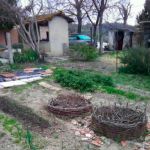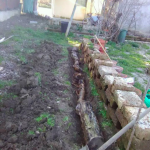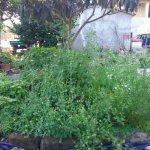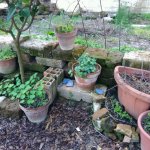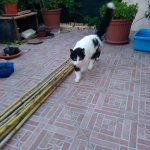In the winter of 2016, I had to move away unexpectedly from Norcia and find a new house. Very close to the end of the time I had for looking, and as I was starting to become desperate, I happened upon a little flat, a portion of an old family farm house, on some prime agricultural land at the base of the mountain upon which the ancient city of Perugia sits, like a grand medieval hat. The place itself was nothing special, being only one bedroom and a good deal smaller than what I was used to. But the main reason I took it was the garden; 200 square meters of hard-packed but very fertile Tiber river silt clay.
A Garden Enclosed
As what I now realise was a form of mental therapy, I immediately set about digging[1]. My wonderful landlady, Annamaria, has been tremendously generous and has given me free reign to do whatever weird Anglo thing I wanted, and has allowed me to use whatever materials were lying around. So I decided to do something I’ve wanted to do all my life; I started building a “Hortus Conclusus,” a style of garden based on medieval monastic design and gardening techniques. Practically, this just means narrow rectangular raised beds forming a square, separated by paths around a round centre bed. In these low raised beds medieval gardeners grew a mix of herbs, flowers and vegetables.
The object of this kind of garden was partly practical and partly symbolic. It was meant to provide food and medicinal herbs, but also intended as a place for monastics to sit and pray, to contemplate and relax, as well as to provide an object for the manual labour part of “ora et labora.” The result is one of the iconic figures of medieval European culture, a delightful place of retreat where beauty and practicality are not in conflict.

The name, “Hortus Conclusus,” Latin for “a garden enclosed” comes from the Song of Solomon, where the human soul in love with God sings of that interior, secret trysting place of the heart, where she is called and goes to meet and commune with the Divine Beloved.
My sister, my spouse, is a garden enclosed, a garden enclosed, a fountain sealed up.
Thy plants are a paradise of pomegranates with the fruits of the orchard. Cypress with spikenard.
Spikenard and saffron, sweet cane and cinnamon, with all the trees of Libanus, myrrh and aloes with all the chief perfumes.
The fountain of gardens: the well of living waters, which run with a strong stream from Libanus.
Arise, O north wind, and come, O south wind, blow through my garden, and let the aromatical spices thereof flow.
Nearly all medieval depictions of the Annunciation – and of Paradise itself – are set in a fragrant and lovely garden of this kind, symbolising the cloistered, contemplative immaculate soul of the Blessed Virgin, miraculously set aside for this one great purpose. This seamless combining of symbolic, mystical and pragmatic elements was something typically medieval, a culture that knew nothing of the harsh compartmentalising that so plagues the thinking of us Moderns. This multilayered concept of the Hortus Conclusus has become a sort of guiding light for me here.
Building; Ora et Labora
One of the big advantages here is the abundance of spare building materials lying around the property. Country people never throw anything away, and there is a great cycle to life here that involves growing, saving, using, and reusing natural materials. A big key in designing and building a garden in the medieval style is to do what they did and use locally available materials. The other day, a neighbour allowed me to come to his property and cut about 45 canes of a bamboo-like native plant that grows wild all over Italy. Italian country people use them for staking up tomatoes and building trellises for pole beans. This little patch, of course, is self-renewing and when you cut a bunch of it, this gives more sunlight to the new shoots. The canes aren’t quite as sturdy as bamboo, so you have to replace the trellises every three years or so, just enough time for new canes to grow. The old canes can be burned for kindling in the winter, or buried in a Hugulkultur bed to provide slow-release organic matter to improve the soil quality.
The progress of the garden over the last year is just the beginning, and the more I do, the more plans resolve. As I was doing it, I started to understand the value of doing this work by hand, learning as you go.
I’ve learned to make raised wattle beds – sides woven like a basket stuck in the ground, out of pruned fruit and olive tree cuttings – and to save every last scrap of green material to add nitrogen to the soil that goes in them.
I’ve been collecting and burying half-rotted wood that, combined with half-composted greens and old carbon material like dead leaves – act like a sponge to retain water in Italy’s ferocious dry summers. Trellises made out of canes and cut prunings will support climbing flowers, placed to create more shade.
I spent most of last summer’s catastrophic 16 week drought working out ways to save the well water while hiding inside[2] from the appalling heat[3], and thought a lot about what life would have been like for medieval people who had no recourse to the supermarket or the DIY mega-stores. You made it work with what you had; you grew food, dug wells, built things by hand, or you died.
This hard reality highlights the falseness of our convenience-worshiping, mass-produced, plastic world, where you buy knock-off authenticity and see no irony in it. It was hard not to compare it all with the absurdity of the garden materials industry.
Look through any online catalogue of garden stuff at any DIY chain store. In Britain you can actually buy pre-made “genuine” mass-produced hurdles to give your garden a more “authentic” and “natural” “country” look.
This is a kind of woven basket-work fence panel made most often from coppiced hazel – hazel wood grown by special techniques intended to create long, flexible poles out of which nearly everything in the middle ages was built[4].
Now and then I go into the garden with my big umbrella, folding chair, and a stack of books. I always intend to read the books, but often end up just sitting and looking at the garden and thinking. One day I was doing this and thought, “If someone were to come here they might easily assume that the beds I’ve built over the last year have been there for a hundred years.” This is simply because I’ve used materials that had just been lying around for about 50 years, out in all kinds of Umbrian weather and exciting seismic ups and downs. The huge pile of terracotta roofing tiles I’m using to create raised beds came from the old stone shed Annamaria’s father built that collapsed in an earthquake in the 70s. The tufa[5] blocks for the rock wall and round bed came from a pile along one side of the property that was so old the ones on the bottom were crumbling into soil. I’ve built it all by hand mainly for the same reason medieval people did; no other choice. Can’t afford to hire someone to come in and do the lifting[6]. And store-bought hurdles are damned expensive!
And the result is as “rustico” as can be. Everything in the garden is wonky. The big round bed in the middle of the garden around the loquat tree is more or less circular, since I used the shovel handle to measure where the edges were and the blocks should go. But it’s wobbly. It’s taller in some places and I dug the stones in deeper in others. And I didn’t level the ground I started with. The beds around that, to form the square layout typical of medieval or monastic garden, are all wonky; there’s not a single straight line or 90-degree angle in the whole thing. At one point I did use two sticks and some twine to fix a line of tiles that was too far off even for me, but I didn’t bother too much about it if it wasn’t perfect. The tufa rockery wall, about three feet high and 12 or so long, is a good three feet out of square with the rest of it. And none of the materials really matched. Even the terracotta roofing tiles, though having been made in a mould exactly the same, are all different shades of colour and texture, after having sat out in the weather for decades.
And that I even thought about this shows that mine is a modern mind. Before the Industrial Revolution, we all knew that real things made by real people are slightly wonky. And the makers of “high end” consumer goods have cottoned on to this. Hence the fad for “distressed” and “reclaimed” wood furniture. And of course, there are now whole websites devoted to “shabby chic” so you can just order that frilly, lived-in, thrift-shop, car boot sale look, pay with PayPal and have it delivered, without ever having to go to a single jumble sale or mend a single bit of lace. Illusory, manufactured authenticity is only a click away.
Cardinal Dolan and the Venetian Trinket Principle

This week I went up to Venice for a couple of days to visit with friends[7]. We went to the treasury of St. Mark’s Cathedral and got to see the extraordinary things stored there. These incredible 10th and 11th century glass and onyx, agate and carved stone chalices, all bound with filigree and granulated gold stuff, covered in exquisite cloisonné images of saints in gold and semi-precious stones, studded with pearls and polished cabochon gems… And every one of them with that slightly wonky effect of things not made by machine. These, despite their divine purpose, were at the same time profoundly human objects, made as something great, the greatest thing those human hands were capable of making, as an offering to God of our very, very best stuff. This was to my mind the essence of art – the material results of human agency – and one of the highest expressions of it I’d ever seen with my own eyes.
I thought about it all again as I was taking the slow boat, the vaporetto, from my lodgings at the top of the island down to meet my friends at their flat near the train station in the centro. We sailed serenely past all those Venetian buildings, every one of them adorned with carved stonework, Baroque saint statues, lions’ heads, grotesques… and absolutely no two of them were exactly alike. Again, this was the work of human beings, human minds and hands, devoted to the greater glory of Venice.


What a contrast these very “real” things made with the awful tawdry mass-produced, plastic rubbish of the trinket shops around the Rialto market; the fake Venetian lace fans and parasols made by machines in Chinese factories, compared with the paintings of 16th century Venetian nobles in their lace collars and cuffs.
I once went to one of the lace and linen shops you can still find near San Zaccharia. I wanted to buy a handkerchief or some other small thing, a napkin maybe. The guy showed me what he had and it was clear it was all machine made. I asked where the real stuff was and he brought out a large, flat box from under the counter, opened it and there, cushioned on acid-free museum-quality storage paper, were three extraordinary, delicate lace handkerchiefs, tiny things obviously never intended to come into contact with a human nostril. The price? About 10 times the cost of one of the mass-produced napkin sets. I asked what had happened to the famous Venetian lace industry. He said, “All the real Venetian lace was made by nuns, and there aren’t any nuns left.[8]” He said there were still about three ancient little old nuns still doing it, but that they would die soon, and that would be the very end of the tradition.
As we become more and more divorced from reality, more hemmed about with machine-made, mass-produced plastic look-alike kitsch we long ever more desperately for the Real Thing. Our entire commercial civilisation has become one titanic game of bait-and-switch. We see celebrities carrying Prada and go and buy plastic knock-off handbags intended to imitate the “real thing”. We buy cheap mass-produced clothes intended to imitate the couture industry’s “real thing”. It’s all one gigantic, global extension of the Venice Trinket Shop principle; let the tourists in to see the actual real thing – the 10th century carved alabaster and gold chalice in the treasury – then sell them the nasty little gondola key chain or the fake lace fan for a couple of bucks. There are about 25 million visitors to Venice every year (in a town of about 50,000 residents). Sell every one of them a fake Chinese lace fan for five Euros and you’ll do all right out of them. Keep ‘em coming.
Meanwhile, the tourist comes home, after having been dazzled with the extraordinary, multi-layered Realness of Venice, looks down and realises he has nothing to show for it but a plastic trinket. He’s been awed by something he senses he desperately needs, then, because it’s all we have left in the darkening end years of our civilisation, has chased after the appearance of the thing, its phantasm, having failed to understand what it was he really wanted, what he went to Venice to find in the first place. He has tried to do something analogous to eating a totemic animal; he’s tried to consume a piece of Venice to make himself more real, but it doesn’t work. You can’t consume the Realness of Venice that way.
It’s like the urge to take pictures. The first time I went to Venice by myself I must have taken 1000+ pictures. As everyone is, I was overwhelmed by the Realness of Venice. I was in a kind of panic to take some of that essence of Realness home with me. But when I got home I didn’t know what to do with a thousand pictures.
This, I suppose, is a useful analogy for the Church too. We saw the Venetian Trinket Principle at work at the vulgar spectacle of that Met Gala that happened while I was looking at medieval carved stones in Venice. One of the worst, most embarrassing, aspects of it was the grinning presence of those Catholic prelates, men who appear to be just as duped by the lies of the modern world as the celebrities dressed up as the Virgin Mary. These are supposed to be the men who carry the Ultimate Real with them to offer to the world, but they’ve forgotten somehow.
That absurdity could maybe be interpreted as just another attempt to swallow the totem animal, the Realness of Catholicism, to absorb its antiquity, meaning, weight and solidity, by appropriating its appearances. These people, the cardinal included, had a strangely desperate air about them, people who were frantic to find something real to attach themselves to, who instead ended up with the plastic gondola key chain.
While I was there I was overjoyed to have a chance to go to an exhibition of John Ruskin’s drawings of Venice, a show based on his famous illustrated book series, “The Stones of Venice”. Ruskin was an early noticer of the direction of falsehood, of inauthenticity, our society was taking, and one of the first to try to call a halt. Of course, he failed, but it was one of the great noble failures.
Ruskin’s philosophy of art and culture, in a more sane time, would have sparked a renaissance-of-the-real. But his voice went largely unheard by those with power, minds bent on the creation of as many gondola key chains as they could turn out. He did inspire William Morris to found the Arts and Crafts movement, an attempt in the midst of the grimness of the industrial age to revive these essentially Catholic and medieval principles of life.
One of his quotes has become a kind of guiding axiom of my own efforts at reclaiming the Real, the origin of my own expression, “Only the Real counts”: “Nothing can be beautiful which is not true.”
NOTES:
[1] One of the great joys of all this is increasing my knowledge of gardening techniques, including soil management. I’ve learned one extremely important rule: if you have clay soil, don’t rototill it. Rototilling destroys the soil’s natural substructure (made by worms and tunneling bugs, plant roots, bacteria and the mycorrhizal network) and surface irrigating washes away whatever organic matter might have been there, which then bakes into a big grey anaerobic brick – a kind of miniature desertification effect. When I came to look at it in March, when all the world was sprouting, the Big Dry Patch had absolutely nothing growing on it. Not even weeds.
[2] There’s a lot to be said for sturdy shutters on the windows and 20-inch thick stone walls.
[3] In the low 40s C. and not a drop of rain until the end of September. Italian agriculture will remember the summer of 2017 as a sign of the End Times; industry losses were calculated in the billions of Euros.
[4] If you read the accounts of the English martyrs, you often hear of them being dragged from the Tower of London to Tyburn Gallows “on a hurdle.” Now you know what that is, and if you watch the video, how to make one, just in case you need to martyr someone in the traditional fashion.
[5] A natural volcanic stone formed when gases are forced through molten rock to create a sort of molten froth that hardens into a spongey lightweight material. Whole mountains are made of it and it’s the most common garden building material in Italy… which, now that I think about it, might provide a cautionary note about the wisdom of living here.
[6] The refrain, “lift heavy things” rolled back and forth in my brain as I was doing it. Apparently this is the type of exercise that staves off osteoporosis, so that worked out.
[7] I know. Sorry. But it is more or less the reason I still live here. You can take trains for very little money and go look at some of the most wonderful things in the world. But if its any consolation, every North American who has lived any time in Italy quickly comes to understand why ex-pats refer to it as a “2nd world nation.” You can only really survive here without driving yourself mad if you never, ever insist on everything (like the radiators in your home, the transit system or the post) working efficiently, and you resign yourself to being more or less poor for the rest of your days.
[8] One of the many fruits of the “New Springtime” of Vatican II; the destruction of one of the great cultural traditions of Venice.


